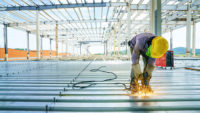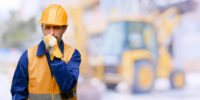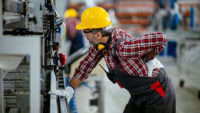Like many worksites, oil and gas sites have potential hazards like falling from elevated platforms, slipping and tripping, and accidents due to lack of proper machine guarding.
It is also common for oil and gas employees to encounter “struck-by” hazards. According to OSHA, the term “struck-by” is defined as injuries produced by forcible contact or impact between the injured person and an object or piece of equipment. The impact of the object striking the employee is the cause of the injury.
Examples of struck-by hazards include:
? A flying object (piece of metal from an equipment component failure)
? A falling object (item falling off the rig)
? A swinging object (drill pipe being lifted from the pipe rack)
? A rolling object (front-end loader, crew truck, semi-truck, water hauler)
Struck-by a flying object
A flying object hazard exists when something has been thrown, hurled or propelled. It can include instances when a piece of material separates from a tool, machine or other piece of equipment and strikes a worker, resulting in an injury or fatality.
Also, this type of hazard exists if an object is ejected under power by a tool or equipment usually designed for that purpose, such as a nail from a nail gun. Powder-actuated tools are particularly hazardous due to the force behind the fastener.
Examples of this hazard would be employees that are struck-by:
? Metal from a tank or pump explosion,
? Thrown equipment resulting from a sudden failure of a component, and
? Part of a shattered grinding wheel or a broken drill bit.
Protect employees from these types of injuries by:
? Installing, inspecting, and maintaining equipment.
? Using power tools as the manufacturer intended and not removing guards.
? Inspecting and ring-testing grinding wheels before using them.
? Using appropriate personal protective equipment.
Struck-by a falling object
This struck-by hazard occurs when the source of injury is an object falling from an elevation to a lower level, including instances where the injured person is crushed, pinned or caught under the falling object.
Objects falling off the rig mast, derrick platform, building roofs, tanks, pipe rack, aerial lifts and scissor lifts can strike employees working nearby. The objects could be tools, drill pipe, fasteners, parts of the platform and other items. Gravity causes the object to travel with speed and force, often resulting in broken bones and puncture injuries.
During rigging up or down, employees are constantly exposed to falling objects. As the derrick is assembled and components are added to it, rig hands are working above other employees on the derrick floor.
When the rig is operating, vibration is produced as a result of tripping in and out and circulatory pumps and diesel engines running. Add the fact that some equipment may have been installed improperly and the level of vibration can increase. This vibration can literally shake pieces of the derrick apart and those pieces can fall onto the roughnecks and the driller working below.
Repeated jarring of the derrick, which can occur when fishing pipe, can also cause objects to become detached and fall. Finally, there may be objects like tools or other small pieces of equipment that were left by mistake on the derrick and are free to fall.
Ways that employers can protect employees from being injured by falling objects involves:
? Using appropriate toe boards on scaffolds and other platforms;
? Requiring PPE, such as hard hats to be used; and
? Identifying and barricading the areas below the work being done.
Struck-by a swinging object
Another hazard rig hands may be exposed to is being struck-by a swinging object. During site preparation work, crushing injuries can result from being struck-by the revolving superstructure of a crane or an excavator. During rigging up and down, materials being lifted also have the potential to strike workers.
Workers can also be struck-by swinging objects such as drill pipe or casing as it is being hoisted up the pipe rack. As the load is lifted, the pipe may suddenly swing, twist, or turn, unexpectedly hitting employees standing nearby.
Employers can protect workers from being injured by swinging objects by:
? Barricading the swing radius of excavators and cranes so workers cannot walk into the path of the equipment.
? Instructing new rig hands on where to position themselves so they can avoid being hit by swinging loads.
? Allowing only trained riggers to rig loads.
? Prohibiting hoist operators from lifting loads over employees.
Struck-by a rolling object
Struck-by a rolling object occurs when an object is rolling, moving or sliding on the same level employees are working at. This includes instances in which the worker is struck or run over by a moving vehicle without being caught under it.
Equipment that can strike workers on oil and gas drilling sites include front-end loaders, crew trucks, semi-trucks and sand and water hauling vehicles.
To avoid these types of hazards, instruct employees to:
? Wear seat belts when provided.
? Check vehicles before each shift to assure that all parts and accessories are in safe operating condition.
? Do not drive a vehicle in reverse gear with an obstructed rear view, unless it has an audible reverse alarm, or another worker signals that it is safe.
? Set parking brakes when vehicles and equipment are parked, and chock the wheels if they are on an incline.
? Make sure all vehicles have adequate braking systems and other safety devices.
Final thoughts
Struck-by hazards can resemble caught–in or –between hazards. There is a distinction which is best explained by asking, “Was it the impact of the object alone that caused the injury?” When the injury is created more as a result of crushing injuries between objects, the event is considered as caught-in.
No matter what the hazard is categorized as, accidents, injuries and fatalities can often be prevented by properly training and educating employees on how to protect themselves at their worksites.



